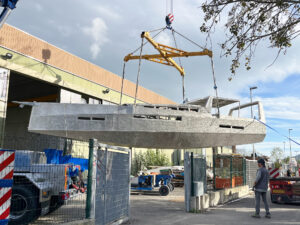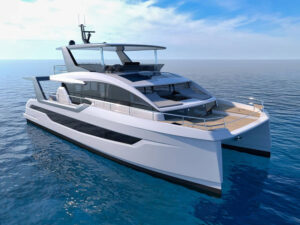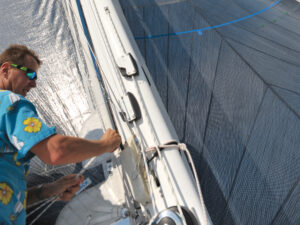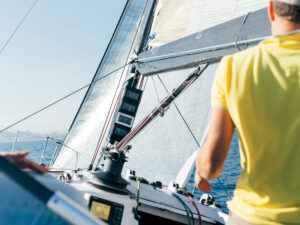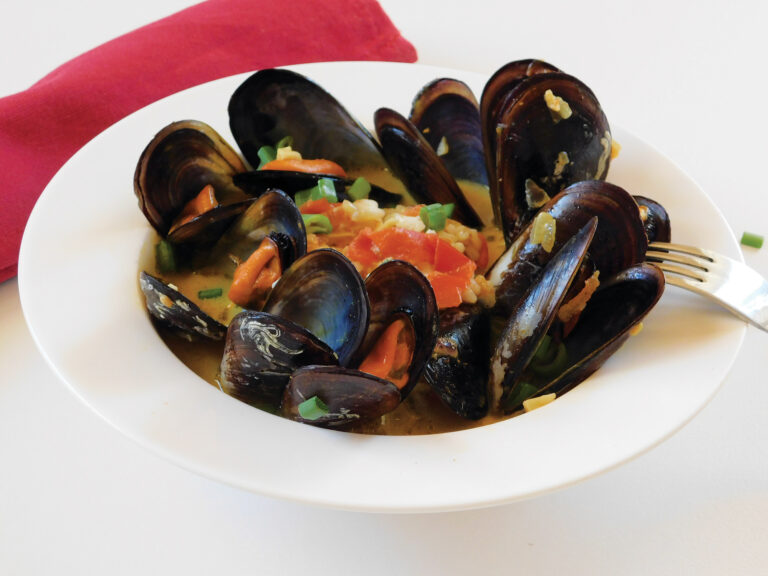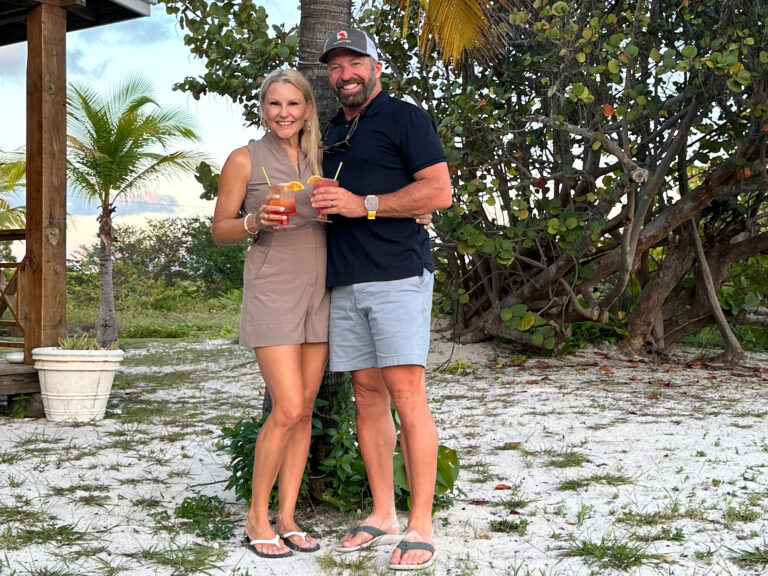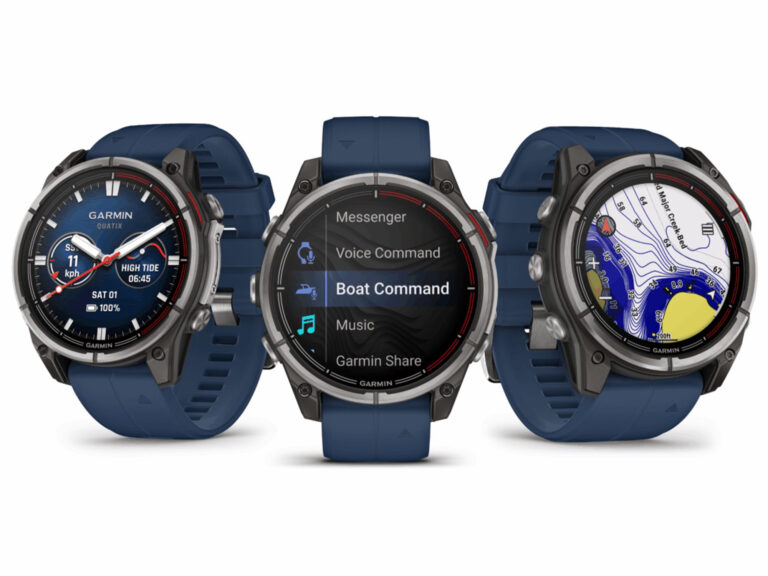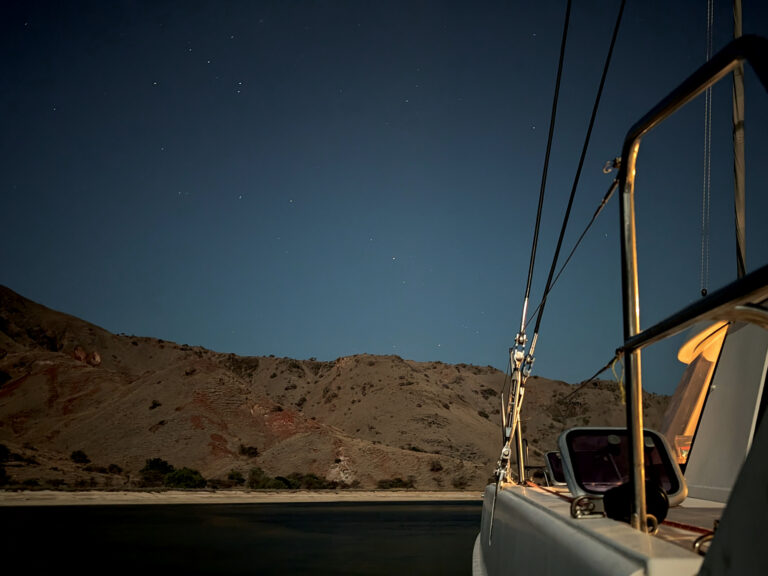If Providencia is a graceful butterfly, San Andres is one busy little cucaracha. This island, on which we’ve thoroughly enjoyed ourselves, comes across at first as the tacky offspring of some perverse, middle-of-the-night, behind-the-barn tryst between Miami and Tijuana. Take a setting that used to strut its stuff, throw in a dash of down-at-the-heel’s glitz; dust it all with an economy that’s been hyperfueled by cocaine; plop into the harbor the Captain Morgan, a replica pirate ship for sunset cruises; add to that a couple of monstrous seaside hotels that are bathed at night in purple lights. Now you’ve got it: concrete in spandex. Here’s a town where sidewalk potholes are large enough to swallow antelope, where screaming motor scooters imperil all who go foolishly into the night, and drunken jet-ski drivers create 24-hour harbor havoc. In my cosmology there’s a special circle of hell for that ilk, in which thousands of miles from any shore, they sputter out of gas and toss for eternity in the worst of waves.
| | Bernadette at the dramatic bronze fish sculpture that graces one of the crossroads in the town of San Andres, and became one of our landmarks to find our way around town. * * *| Only 110 miles from Nicaragua but 440 miles from Colombia, San Andres has been a political football often tossed between Spain, England, and Colombia, who has been nominally in charge since the beginning of the 19th century. Surrounded by stunning reefs in see-through water, San Andres is physically gorgeous. Only seven miles long and less than 2 miles wide, with its highest mountain reaching 55 feet, this is a place where the gentle and drowsy songs of nature have been drowned out by the cacophony of jets and generators.
In its current incarnation, San Andres is the vacation get-away for mainland Colombians whove signed up for inexpensive, group-charter flights. They descend on this formerly duty-free port with the crazed hope theyll find bargains of a lifetime. No way. But on they march, bikini-clad, through store after store, ogling washing machines, coffee makers, Mont Blanc pens, Lladro figurines, cameras, and watches. Were not sure why folks come here for these products, because after 1994, the duty-free status went kaput, but maybe no one on the mainland got the memo. Local merchants with whom we made friends tell ussomewhat unnecessarily when you look at half-finished, deteriorating buildingsthat, economically, San Andres is on a downhill slide. The serious tourist season only exists here around Easter and Christmas, and the rest of the year the Arab shopkeepers (many of the women are still in chandoors) who own most of the electronic and grocery stores are hurting.
| | In one of the terrific local grocery stores, you can buy everything from imported olives and prosciutto, to aerosol cans containing elixirs that will rid your house of bad spirits, help you to make more money, bless you with benedictions, and improve your sexual powers. This is still an island of contrasts between the past and the present; some locals still believe in Santeria. * * *| So why do I love it here? This place is dead easy! The government has put in place the finest buoy system weve seen outside of the States. There are many wonderful cheap restaurants, and the grocery stores, especially the Lebanese-owned, have selections of Greek olives, Syrian hummus, California grape leaves, Spanish wine, German prosciutto, Egyptian figs and some of the finest, most unusual fruits Ive ever seen. San Andres town may be tawdry and loud, but come on baby, bring it on. When it comes to provisioning, weve hit the mother lode of yuppieland.
Our favorite restaurant, to which we’ve worn a path on the sidewalk, is La Fonda. It’s only about a five-minute walk from the dinghy dock at Club Nautico on Punta Paraiso, off which we’re anchored. (Nautico’s membership is $10 for visiting boats, and that includes free water fill-ups, a safe dinghy-landing, use of the pool, restaurant, tennis courts, cable television, and a guard at the gate who’ll accept deliveries for you from the grocery markets and liquor stores.) La Fonda may have a limited menu of beans, rice, chicken, pork, and fish in various combinations, but they’re all mouth-wateringly good and the portions exceed generous. The “frijoles con cerdo” for example, consists of a bathtub-sized tureen of red beans in a smoky tomato sauce, a mountain of rice, crisp green salad, and what looks like half a grilled piggy. That’s $4.50. Double shots of rum are about a buck, and a beer is less than that.
| | On every street of downtown San Andres are the prideful vendors with their barrows laden with gorgeous local and imported fresh fruits. * * *| The difficult question with Colombian rums is to choose between the Medellin and the Caldas. I prefer the Caldas, not so much because it tastes any better, but in a free-wheeling, well-lubed argument of merits, Gregory, a local fellow whos the guard at the very friendly Toninos Marina, right next door, said he wouldnt dare drink the Medellin because the label has a picture of a spider web, and “you know if you get into that, you might not escape by tomorrow.” This sort of reasoning appeals to me, so as an act of solidarity weve stocked up with Caldas before our trip down to the San Blas, where theres no provisioning to speak of. A half gallon of Caldas in the shops is less than $10. Rum is cheap everywhere where theres sugar cane, which is to say warm places, and that may help explain why so many cruisers become terminal rummies.
| | Once outside the downtown tourist hive, we found local people who welcomed us. These ladies had a table of their mouthwatering home-cooked foods, a mammoth plate of which came to less than $2. * * *| There are a number of ways to rank and rate countries: You can use GNP, birth and death indices, literacy, size, populationall kinds of data you can find in a World Bank or UNESCO file. Personally, I prefer drink and food, which are more immediate and selfish yardsticks, but just as valid. My friend Frank, on _Simba_, rates a nation on the basis of its mangos. I think of this as Franks Mangosity Scale and, so far, according to his research, Belize is the winner. I prefer a hot-pepper index, because peppers actually do have a recognized unit of hotitudiness, called Scoville units, which refers to the quantity of capsaicim they contain. Habanero peppers, which are plentiful hereand therefore give San Andres pretty high numbers on my scaleare about the hottest Ive found. When we lived on land, I willy-nilly ordered Habanero sauces from a terrific mail order source in New York City called “Mo Hotta Mo Betta,” and I was generally pretty pleased, but since underway Ive been making my own.
| | Hot and spicy habanero peppers * * *| Bernadette wont touch the stuff, or even kiss me after Ive been cooking with these peppers. She wont even touch the little cutting board I dice on and maintains Ive lost all sense of proportion. You decide. Heres my latest recipe, which, she notes, is hardly delicate.
- Take 42 habanero peppers (that’s all I could find in a recent shopping excursion)
- Remove and throw away the stems, then chop the peppers finely and leave in the seeds.
- Add 2 tablespoons of ground cumin, 1/2 teaspoon of salt, 4 full heads of finely minced garlic (yes, four whole heads), 1/4 cup of chopped fresh cilantro, 1 cup of finely chopped onion and 1 teaspoon of freshly cracked peppercorns
- Marinate everything in one quart of white vinegar (white balsamic is my favorite) and 1/2 cup fresh lime juice. (Don’t use tomatoes. They seem to soften the bite, and the purpose of this recipe is to test one’s endurance)
- Allow your brew to marinate and sizzle for several hours in a bottle, then enjoy. However, never ever wipe your eyes while making your mix.
| | This little fruit may look like a pineapple, but it tastes like ambrosiaa cross between a grape and a kiwi. * * *| On the kinder and gentler side of life, weve been loving the local fruits, some of which are strange-looking and new to us. The scraggly looking yellow fellow in the photo has been called several things, and we still dont know its legitimate name; the rind is thick but soft, and the sweet meat inside reminds me of a cross between concord grapes and kiwis. _Uchuvas_ are about the size of a marble and the color of a tangerine. You can pop several into your mouth at a time like peanuts and eat the skin and meat. Ranging in taste from sweet to tart, the combination is a wondrous sensation and you can roll them around on your tongue blissfully. Sometimes I think cruising is merely an excuse to eat new foods, washed down with interesting new booze.
| | Pomellos are filled with a sweet jell of delicious seeds that we like to spoon over our yogurt or mix with other fruits for a magnificent tropical salad. * * *| The pommelo is probably the sweetest fruit Ive ever had. Its the size of a small pear with a shell about 1/16-inch thick and slightly crisp. When you lop off the top, up by the stem, revealed before you is a nearly gelatinous heap of milky pods with black seedsnot all that pretty, come to think of it, but dont let that deter you. With a spoon you can dislodge the mass from the shell, dig it out and savor teeny bites. But because the consistency is reminiscent of oysters, if no ones looking, the _only_ way to eat a pommelo is to suck and slurp. The Commodore maintains my table mannersall my manners, reallyhave tanked something fierce, and pommelo offers irrefutable evidence. But be honest, havent you always admired the courageous soul who swallowed that first oyster?
| | We found that the island is home to a large Rasta population. Gentle people with dreadlocks, and images of Bob Marley were everywhere, as was the sounds of his sweet music. * * *|
One of the great pleasures here is that San Andres is a crossroads. For boats coming north from Colon, Cartagena, and the San Blas, this is a place to stop and rest, to reprovision and to connect with the southbound travelers. Last night at dinner, Sand Dollar, Ithaka and Simba (all headed south) marched off to La Fonda in the company of Indara, Lydia B., Dalliance and Restless (all headed north) and today for several hours at Club Nautico together we pored through cruising guides, amended data, traded waypoints, routes, recommended anchorages, sites to avoid at all costs, and tips in general. The boats who’d come south from California and on through the Panama Canal are intensely curious about the conditions in the Caribbean. We devour information on the San Blas.
At these get-togethers cruisers often exchange boat cards. Ours is prosaic, crisp, and understated. No flourishes or photos, but graceful, I think, and clear. I suppose all cards present whom they describe in subtle and sometimes unintended ways. Others can be intentionally over the top, feisty and bold. Today, George and Ginger Robinson, on Dalliance, a Lancer 36, won the card award for most audacious humor in defiance of reality. Along with the usual information—name, e-mail address, homeport—their card includes a cartoon depiction of themselves reclining on lounge chairs under a palm tree, drinks in hand, each of them missing their left leg, which is true. Their logo reads: “Sailing on our own two feet.” Bravo, Dalliance!
| | Bernadette at the famous blow hole of San Andres. Its hard to capture in a photo, but the powerful surf comes crashing in here, is forced through a natural tunnel under the rocks, and comes spewing out of a two-foot hole and high up into the air at intense velocitya dramatic sight, and a wet experience. * * *|
San Andres is an island of luxuries. Wonderful Spanish wines, restaurants so plentiful and inexpensive we havent cooked dinner on the boat for the past week, and my Commodore has been visiting the pamper-me salons for a facial and massage that are so cheap and beautiful, she claims, that they demand her participation.
| | After a couple of days, the tarnished glitz of San Andres began to disappear for us, giving way to the warm soul of the island. (Thats when the place really seemed to grow on Douglas.) * * *| Sometimes (mercifully!) cruising is not about high winds, dubious anchorages, rolling seas, broken parts, scrubbing fish blood from the teak or testing ones never-ending capacity for inconvenience. Instead its about the indulgent pleasures of life. You know it cant last long, so, have some olives, treat yourself to the next glass of wine, tear off another hunk of that warm brown bread from the bakery, and Welcome To San Andres!
e-mail the Bernons: [email protected]

